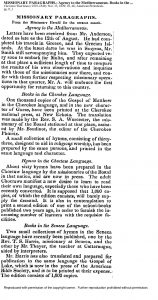While we weren’t able to take much time on it, I was intrigued by the article we looked at in class on Native American hybrid music. In my research, I happened upon the names of a few hymn books, but the one that interested me the most was the Chahta Vba Isht Taloa Holisso of the Choctaw. I was also able to find corresponding letters from the missionaries who had shared their hymns with them, which I found interesting.
The hybridization of Native American music and Christian hymnody adds complexity to the oftentimes oversimplified narrative of the erasure of Native American culture. While the Choctaw welcomed the missionaries and adopted the tradition of hybridized music, other groups reluctantly converted, and “…people [who] had initially pretended to convert in order to survive, went on to ask, ‘At some point, did we forget we were pretending?’”[1] Such practices oftentimes came about through generations of forced acculturation; however, for some groups, they were accepted into the culture, expanded upon with original works and have been ingrained within their practices to the point of becoming a part of their musical tradition.

“MISSIONARY PARAGRAPHS.: AGENCY TO THE MEDITERRANUEAN. BOOKS IN THE CHEROKEE LANGUAGE. HYMNS IN THE CHOCTAW LANGUAGE. BOOKS IN THE SENECA LANGUAGE.” Christian Watchman (1819-1848), Nov 13, 1829
While we’ve been talking in class about the “Vanishing Indian” trope in the context of 19th century classical music, I believe the same ideas of misplaced nostalgia and oversimplification are prevalent today and relevant to the delegitimization of modern Native American culture. As hinted at in some of the letters above, Choctaw were thought to be more receptive to conversion due to the available access of their language in printed form. This aspect might have aided in their conversion; however, it also aided in the preservation of their language and the transmission of what is now seen by them as their own traditional music. The collection and performance of these hymns, original and translated, have helped the Choctaw maintain its ethnic identity through frequent meetings and the continued use of native language [2]. While these hybrid forms were born out of the gruesome history of Native American genocide and cultural erasure, to invalidate this living tradition due to its western sound is, in my opinion, just as problematic as the commodification of a curated characterization of what this music ‘should’ sound like.
_____
- “Musical Interactions.” Garland Encyclopedia of World Music Volume 3 – The United States and Canada. Ed. Ellen Koskoff. Routledge (Publisher), 2000. 510-20. Music Online: The Garland Encyclopedia of World Music Database. Web.
- STEVENSON, G. W. (1977). The Hymnody Of The Choctaw Indians Of Oklahoma (Order No. 7802869). Available from ProQuest Dissertations & Theses Global. (302857576).
Works Cited:
Chahta Vba Isht Taloa Holisso : Choctaw Hymn Book. Richmond, Va, 1872. Print.
“MISSIONARY PARAGRAPHS.: AGENCY TO THE MEDITERRANUEAN. BOOKS IN THE CHEROKEE LANGUAGE. HYMNS IN THE CHOCTAW LANGUAGE. BOOKS IN THE SENECA LANGUAGE.” Christian Watchman (1819-1848), Nov 13, 1829, 1, https://search.proquest.com/docview/127208190?accountid=351
“MISCELLANEOUS.: CHAHTA VBA ISHT TALOA. CHOCTAW HYMN BOOK, 18MO, PP. 84. BOSTON: CROCKER & BREWSTER. ALPHABET.” American Annals of Education (1830-1839) 1, no. 11 (11, 1831): 537. https://search.proquest.com/docview/89620393?accountid=351.
“Musical Interactions.” Garland Encyclopedia of World Music Volume 3 – The United States and Canada. Ed. Ellen Koskoff. Routledge (Publisher), 2000. 510-20. Music Online: The Garland Encyclopedia of World Music Database. Web.
STEVENSON, G. W. (1977). The Hymnody Of The Choctaw Indians Of Oklahoma (Order No. 7802869). Available from ProQuest Dissertations & Theses Global. (302857576).


Amen! This issue is such a tricky one, but you handle it beautifully. We have to acknowledge that conversion was often forced, but also heartfelt, and became deeply rooted over generations. Your discussion of the way Choctaw literacy played into the process of conversion and acculturation is particularly insightful. It all leaves me wondering: what would US American history look and sound like if portrayals of Native Americans had focused as much on Christian musicking as on indigenous religious musicking? Great research and writing here!